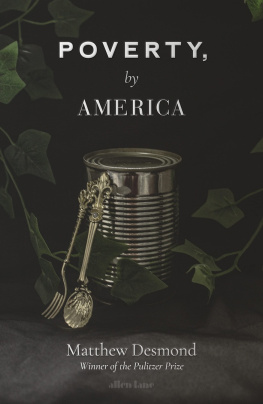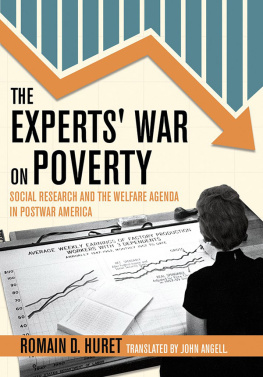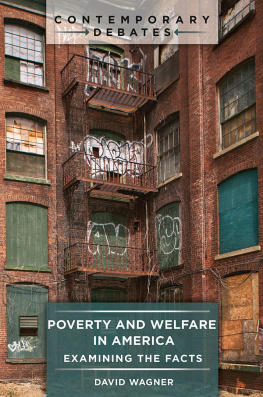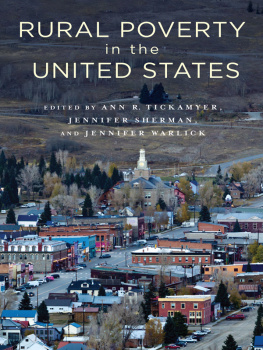dilemmas of social reform
dilemmas of social reform
Poverty and Community Action in the United States
SECOND EDITION
PETER MARRIS & MARTIN REIN
First published 1967 by Transaction Publishers
Published 2017 by Routledge
2 Park Square, Milton Park, Abingdon, Oxon OX14 4RN
711 Third Avenue, New York, NY 10017, USA
Routledge is an imprint of the Taylor & Francis Group, an informa business
Copyright 1967, 1973 by Peter Marris and Martin Rein.
All rights reserved. No part of this book may be reprinted or reproduced or utilised in any form or by any electronic, mechanical, or other means, now known or hereafter invented, including photocopying and recording, or in any information storage or retrieval system, without permission in writing from the publishers.
Notice:
Product or corporate names may be trademarks or registered trademarks, and are used only for identification and explanation without intent to infringe.
Library of Congress Catalog Number: 2006048166
Library of Congress Cataloging-in-Publication Data
Marris, Peter.
Dilemmas of social reform: poverty and community action in the United States / Peter Marris and Martin Rein.
p. cm.
Includes index.
ISBN 0-202-30256-3 (alk. pbk.)
1. United StatesSocial policy. 2. Community organizationUnited States. 3. PovertyUnited States. I. Rein, Martin, 1928- II. Title.
HN65.M32006 |
362.50973dc22 | 2006048166 |
ISBN 13: 978-0-202-30256-0 (pbk)
CONTENTS
We would like to thank the Ford Foundation and the Presidents Committee on Juvenile Delinquency and Youth Crime for their financial support, and in particular, Paul N. Ylvisaker and the staff of the Foundations Public Affairs Programme for their friendship, for the stimulus of their ideas, and for their tactful encouragement of ruthless impartiality. Few of our ideas can pretend to be original. As we went round talking to project directors, research directors and programme staff; interviewed mayors and civic leaders; discussed with members of Federal departments, we absorbed their insight and knowledge, and tried to make a coherent synthesis of all these points of view. If we have abused their ideas, we can only plead the inherent complexity of the events and issues to be understood, and thank them all the more for their time and patience. Besides members of the Projects staff, we have learned a great deal from discussion with other sociologistsespecially Herbert J. Gans, S. Michael Miller, Frances Piven, and Frank Riessman. Many of these read the book in draft, and helped us with their comments and corrections. We would like to thank all those associated with the Presidents Committee, the Office of Economic Opportunity, and members of the staff and advisory committee of the Institute of Community Studies who also gave us their comments. Diana Rodricks typed the manuscript. Tom Knutt helped prepare much of the additional material for the epilogue. Besides those we have already mentioned, we would like to thank Daniel P. Moynihan and Robert A. Levine for their comments on a draft of these additional sections
The original material for this study was gathered in 1964, and the book was written in the following year. For this new edition, we have brought the history of community action up to date by adding an outline of events between 1965 and 1970model cities legislation, the decline of the anti-poverty program, the use of legal intervention as a strategy of reform. We have not altered the original text, because it still seems the best attempt we can make to understand the ideals, dilemmas, and politics of community action in the earlier years. More recent history has again and again repeated the same endeavors and encountered the same conflicts. But in the new material we have gone back over the origins of the anti-poverty program, to bring out more clearly why President Kennedys concern to make poverty an issue of policy should have led to an emphasis on community action, and how this influenced the controversies that followed. We have reviewed other interpretations of these controversiesespecially Daniel P. Moynihans Maximum Feasible Misunderstandingwhich differ from our own.
We have also added a further section on community action interpreted as an attempt to revitalise the processes of government, for it is in this senserather than as a means of relieving povertythat we think it has the most lasting importance. We have tried to articulate the criticisms of established democratic process which the prin-ciples of community action implied, and to show where its own conception of reform faltered.
So this new chapter, as well as discussing the subsequent five years, also tries to set the study in a broader context: first, by interpreting the political motives and constraints that led to the adoption of community action as a principal strategy of a nationwide war on poverty; second, by discussing the underlying weaknesses of democracy that community action implied and sought to tackle. Both these issues are as relevant now as when the first tentative proposals for experimental demonstrations of reform were put forward over a dozen years ago.
Since the book was initially written for both British and American readers and the British edition happened to be the first to appear, English spellings have been retained in the American edition for convenience of publication. We have also taken American institutions and the traditions of American democracy less for granted than if we had been writing for American readers alone. We are very concerned with the relevance and productiveness of community action, and at the same time, we have tried to present it as a characteristic aspect of American political processesthat blending of radical imagination with conservatism, at once shrewd, hypocritical, idealistic and dispairing. But if detachment makes one see the uniqueness of America more sharply, it also suggests comparisons. The history we have recorded here is important, not only because it reveals something of the inherent dilemmas of social reform in America, or because it helped to articulate a new conception of the democratic rights implied in the constitution of the United States. It raises issues which any highly industrialised urban democracy must struggle to resolve.
I N this book we set out to examine, in the light of one experiment, some of the principles, dilemmas and frustrations with which social reform in America must grapple. The particular projects with which we shall be concerned were few, and their scope limited, but they represent the most imaginative and ambitious attempt to manipulate deliberate social change in the years 19601964. These projects were promoted, and largely financed, by the Ford Foundation and the Juvenile Delinquency and Youth Offences Control Act of 1961: absorbed into the poverty programme, and diffused as a national strategy, they are now known as community action projectslocal agencies, drawing on federal funds, which concert the resources of a community in a democratic, coherent attack upon the handicaps of the poor. But though, from the first, this movement of reform was concerned with poverty, it arose less from protest or moral indignation at injustice, than from a sense of breakdown in the institutions which should be diffusing opportunities to all. The reformers in the Ford Foundation, in the Presidents Committee on Juvenile Delinquency, and the executives of the projects they funded were intellectuals, for whom poverty was more a problem in social engineering, than a cause. They attacked it by expert knowledge and political manoeuvre, as technicians to whom the guidance of social change was a career. This study is concerned, then, with strategies of reform, as they appeared to a group of dedicated professionals working within the limits of community action.









